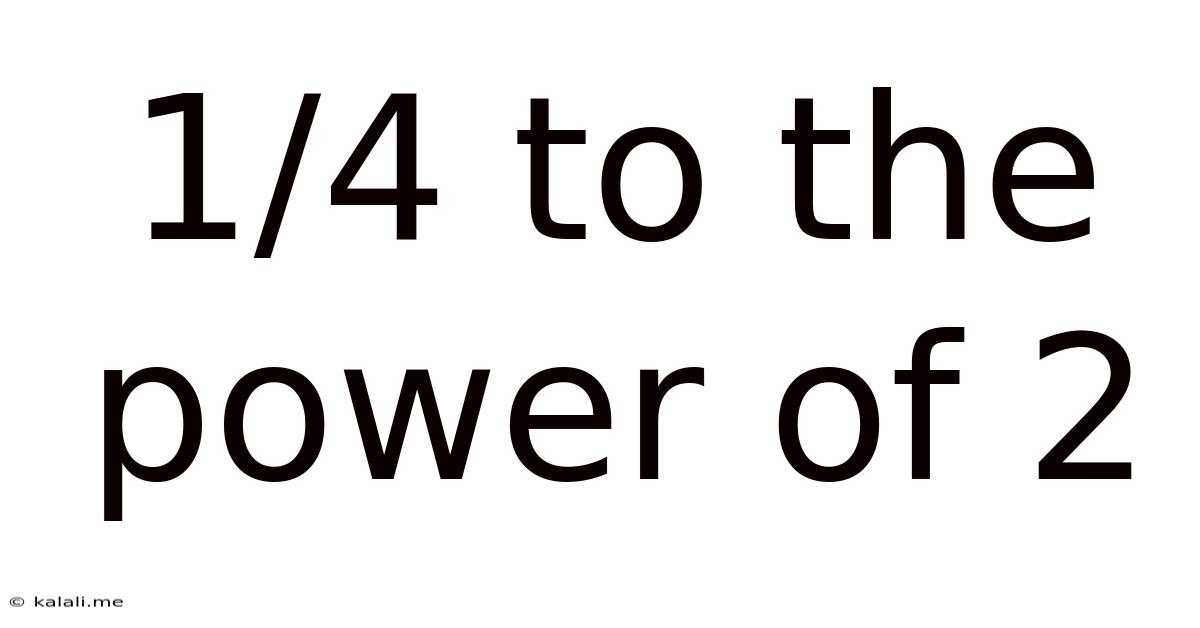1/4 To The Power Of 2
Kalali
Apr 12, 2025 · 4 min read

Table of Contents
Decoding 1/4 to the Power of 2: A Deep Dive into Exponents and Fractions
This article will explore the seemingly simple mathematical expression, (1/4)² , delving beyond the basic calculation to uncover the underlying principles of exponents and fractions, and showing how these concepts apply to various mathematical fields and real-world scenarios. We'll cover the calculation itself, explain the rules governing exponents and fractions, and illustrate the broader implications of this seemingly simple equation. Understanding (1/4)² is more than just getting the right answer; it's about grasping the fundamental building blocks of mathematics.
What is (1/4)²? The Basic Calculation
At its core, (1/4)² means (1/4) multiplied by itself. Therefore, the calculation is straightforward:
(1/4)² = (1/4) * (1/4) = 1/16
The answer is 1/16. This is the simplest and most direct way to solve the problem. However, understanding why this is the answer requires a deeper understanding of exponents and fractional arithmetic.
Understanding Exponents
Exponents, also known as powers or indices, represent repeated multiplication. In the expression a<sup>n</sup>, 'a' is the base and 'n' is the exponent. The exponent indicates how many times the base is multiplied by itself. For example:
- 2³ = 2 * 2 * 2 = 8
- 5² = 5 * 5 = 25
- x⁴ = x * x * x * x
In our case, (1/4)² the base is 1/4 and the exponent is 2. This means we multiply 1/4 by itself twice.
Working with Fractions
Fractions represent parts of a whole. They consist of a numerator (the top number) and a denominator (the bottom number). When multiplying fractions, we multiply the numerators together and the denominators together:
(a/b) * (c/d) = (ac) / (bd)
Applying this rule to our problem:
(1/4) * (1/4) = (11) / (44) = 1/16
Extending the Concept: Negative Exponents and Fractional Exponents
While our example uses a positive integer exponent, the concept of exponents extends far beyond this.
-
Negative Exponents: A negative exponent signifies the reciprocal of the base raised to the positive exponent. For instance:
a<sup>-n</sup> = 1 / a<sup>n</sup>
Therefore, (1/4)<sup>-2</sup> = 1 / (1/4)² = 1 / (1/16) = 16
-
Fractional Exponents: Fractional exponents involve roots. For example:
a<sup>m/n</sup> = <sup>n</sup>√a<sup>m</sup>
This means taking the nth root of a raised to the power of m. This concept introduces the relationship between exponents and radicals, expanding the possibilities significantly. Understanding fractional exponents allows for solving equations like finding the square root of a number, or calculating the cube root of a number raised to a power.
Real-World Applications
The principles illustrated by (1/4)² are far from abstract; they have numerous real-world applications:
-
Area Calculations: Imagine calculating the area of a square with sides of length 1/4 meter. The area would be (1/4)² = 1/16 square meters. This simple calculation extends to more complex geometric shapes and various measurement systems. This is fundamental to architecture, engineering, and design.
-
Compound Interest: Compound interest calculations utilize exponents. If you invest a principal amount and it earns interest compounded quarterly, the exponent reflects the number of quarters. Understanding exponents is crucial for financial planning and investment strategies.
-
Probability: Probability calculations often involve exponents when dealing with independent events. For example, the probability of flipping a coin twice and getting tails both times is (1/2)² = 1/4. This principle is foundational to statistics and risk assessment.
-
Physics and Engineering: Exponents are vital in various physics and engineering disciplines. They appear in equations related to motion, electricity, and various other phenomena. For instance, the inverse square law, which describes the intensity of radiation decreasing with the square of the distance from the source, frequently uses exponents.
Beyond the Basics: Advanced Concepts
The simple calculation of (1/4)² opens doors to more complex mathematical concepts:
-
Logarithms: Logarithms are the inverse of exponents. They help solve equations where the unknown is an exponent. Understanding logarithms is essential for advanced mathematics and scientific applications.
-
Exponential Functions: Exponential functions, where the variable is in the exponent, describe phenomena with rapid growth or decay, such as population growth, radioactive decay, and compound interest.
-
Calculus: Derivatives and integrals, fundamental to calculus, frequently involve manipulating exponents and powers. Understanding exponents is a prerequisite for grasping more advanced calculus concepts.
Conclusion: The Significance of a Simple Equation
While the calculation of (1/4)² might appear trivial, it serves as a gateway to a vast landscape of mathematical principles and their real-world applications. From basic fractional arithmetic to advanced concepts like logarithms and calculus, understanding exponents and fractions is crucial for navigating various academic and professional fields. This simple equation underscores the interconnectedness of mathematical concepts and their practical relevance in our daily lives. Mastering the fundamentals of exponents and fractions empowers you to tackle more complex mathematical problems and enhances your understanding of the world around us. The ability to readily solve (1/4)² and understand the underlying principles showcases a fundamental grasp of mathematical reasoning and its widespread applications. Remember, mathematics is not simply about numbers; it's about understanding the relationships between them and applying that understanding to solve problems.
Latest Posts
Latest Posts
-
60 Is What Percent Of 70
Apr 18, 2025
-
138 Cm Is How Many Inches
Apr 18, 2025
-
How Big Is 38 Cm In Inches
Apr 18, 2025
-
How Many Inches Is In 120 Cm
Apr 18, 2025
-
60 In Equals How Many Feet
Apr 18, 2025
Related Post
Thank you for visiting our website which covers about 1/4 To The Power Of 2 . We hope the information provided has been useful to you. Feel free to contact us if you have any questions or need further assistance. See you next time and don't miss to bookmark.